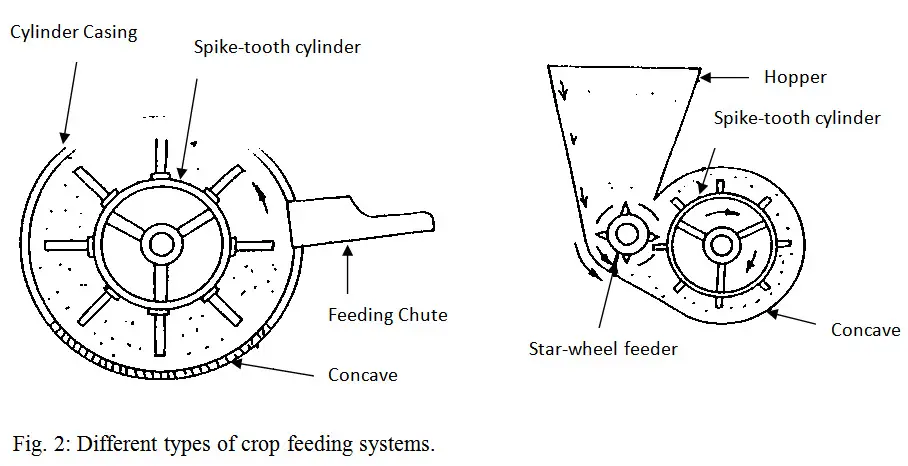This post may contain affiliate links which means I may receive a commission for purchases made through links. Learn more on my Private Policy page.
Have you ever wondered about the fascinating world of threshers and how they work? Threshers come in various types, each serving a unique purpose in the agricultural industry. From the flail thresher to the rotary thresher, these machines are designed to separate grains from plants effortlessly. Join us as we explore the different types of threshers and unravel the fascinating mechanisms behind their efficient operation. Get ready to dive into the world of threshers and discover the key to maximizing productivity in the field.
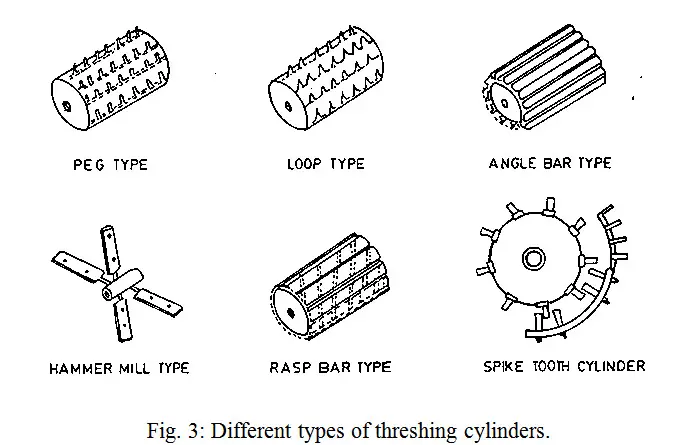
This image is property of ecoursesonline.iasri.res.in.
1. Traditional Threshers
1.1 Drum Threshers
Drum threshers are one of the oldest types of threshers, traditionally used for separating grains from their stalks. As the name suggests, these threshers consist of a large drum with paddles or spikes attached. The drum rotates at a high speed, and the grain stalks are fed into the threshing chamber through a feeding mechanism. The rotating drum then beats against the stalks, causing the grains to separate from the straw. The separated grains are then collected, while the straw is expelled from the thresher.
1.2 Spike-Tooth Threshers
Spike-tooth threshers, also known as tooth-and-spiked-cylinders threshers, are another type of traditional thresher. These threshers utilize a toothed cylinder with spikes or teeth to thresh the grain. As the stalks are fed into the thresher, the toothed cylinder rotates and pulls the stalks between the spikes, effectively removing the grain. The separated grains fall through the gaps between the spikes, while the straw is expelled from the thresher.
1.3 Wire-Loop Threshers
Wire-loop threshers are yet another type of traditional thresher commonly used in agricultural settings. These threshers have a series of wire loops or belts that rotate around a cylinder. The grain stalks are fed into the thresher, where the rotating wire loops thresh the grain by pulling it between the belts and the cylinder. The separated grains pass through the gaps between the belts, while the straw is expelled from the thresher.
2. Modern Threshers
2.1 Rotary Threshers
Rotary threshers are among the modern types of threshers widely used in agricultural practices today. These threshers employ a combination of a rotating drum and a beater system. The drum contains many small paddles or interconnected tubes, which agitate the grain stalks as they pass through the threshing chamber. The beater system further aids in separating the grains from the straw by applying additional force. The separated grains are then collected, while the straw is expelled.
2.2 Axial-Flow Threshers
Axial-flow threshers are another type of modern thresher commonly used in large-scale agricultural operations. These threshers utilize a unique flow path design to separate the grain from the straw. The grain stalks are fed into the thresher, which contains a threshing rotor. As the rotor rotates, the grain stalks are subjected to a combination of impact and rubbing forces, effectively separating the grain from the straw. The separated grains are collected through a separation stage, while the straw is expelled.
2.3 Spike-Tooth-Cylinder Threshers
Spike-tooth-cylinder threshers combine the principles of both spike-tooth and drum threshers. These threshers feature a combination of toothed cylinders with spikes and a rotating drum. The grain stalks are fed into the thresher, where the toothed cylinders and the drum work in tandem to separate the grain from the straw. The toothed cylinders pull the stalks between the spikes, while the rotating drum further aids in separating the grain. The separated grains and straw are then collected and expelled, respectively.
2.4 Centrifugal Threshers
Centrifugal threshers are another modern type of thresher commonly used in agricultural settings. These threshers employ a drum and beater design, similar to rotary threshers. However, in centrifugal threshers, the drum and beater system are shaped to create a centrifugal force. As the grain stalks are fed into the thresher, the rotating drum and beater system generate centrifugal force, effectively separating the grain from the straw. The separated grains and straw are then collected and expelled, respectively.
3. Thresher Components
3.1 Threshing Cylinder
The threshing cylinder is a crucial component found in most types of threshers. It is typically a cylindrical structure that rotates at a high speed and performs the actual threshing process. Depending on the type of thresher, the threshing cylinder is equipped with either spikes, teeth, wire loops, or other threshing elements that help separate the grain from the stalks.
3.2 Concave
The concave is another essential component of a thresher, usually located above the threshing cylinder. It helps in directing the grain stalks towards the threshing mechanism and ensures a more efficient separation of grain from stalk. The concave’s design may vary depending on the type of thresher and the crop being processed.
3.3 Separation Drum
Many modern threshers, such as rotary and centrifugal threshers, feature a separation drum or rotor. This component helps separate the grain from the straw after the threshing process. The separation drum utilizes different mechanisms, such as rotational motion or specific designs, to guide the separated grains through while allowing the straw to be expelled.
3.4 Cleaning System
Threshers often include a cleaning system to remove any impurities or foreign material from the separated grains. The cleaning system may consist of sieves, air blowers, or other mechanisms that help separate the grains from debris, such as chaff or dirt. This ensures that the collected grains are of a high quality for further processing or storage.
3.5 Power Source
All types of threshers require a power source to operate. The power source can vary, depending on the scale of operation and the available resources. Threshers can be powered by electricity, internal combustion engines, tractor power take-offs (PTO), or even manual labor in smaller, traditional threshers. The power source drives the various components of the thresher, such as the threshing cylinder, the separation drum, and the cleaning system.
4. How Traditional Drum Threshers Work
4.1 Feeding Stage
In traditional drum threshers, the grain stalks are manually or mechanically fed into the thresher’s hopper. The feeding mechanism transports the stalks to the threshing chamber, where they come into contact with the rotating drum.
4.2 Separation Stage
As the drum rotates, the paddles or spikes attached to it beat against the stalks. This process separates the grain from the straw, as the force applied by the rotating drum causes the grains to detach from the stalks.
4.3 Cleaning Stage
After the separation stage, the separated grains and straw are directed to a cleaning system. The cleaning system removes any remaining straw, chaff, or debris that may be mixed with the separated grains.
4.4 Power Transmission
Traditional drum threshers are typically powered by a belt-drive system connected to an external power source, such as a tractor or a stationary engine. The power source drives the rotating drum and other components of the thresher, enabling the threshing process.
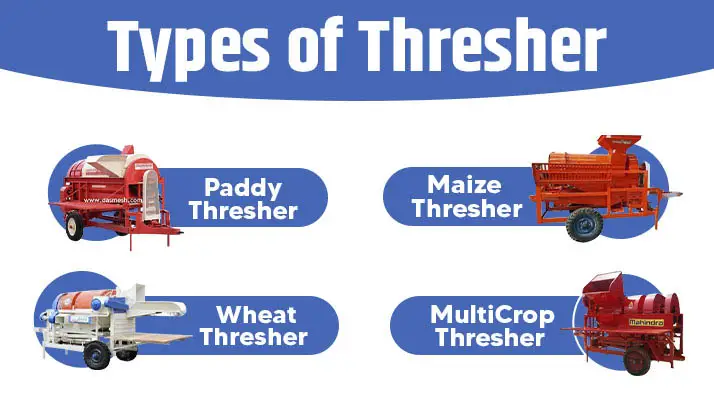
This image is property of www.tractorjunction.com.
5. How Spike-Tooth Threshers Work
5.1 Operation Mechanism
Spike-tooth threshers operate by pulling the grain stalks between toothed cylinders with spikes. The threshing cylinders rotate, allowing the spikes to engage with the stalks and separate the grain from the straw.
5.2 Feeding and Threshing Stage
The grain stalks are fed into the thresher, where the toothed cylinders pull them between the spikes. The spikes agitate the stalks, effectively threshing the grain and separating it from the straw.
5.3 Cleaning Stage
After the threshing stage, the separated grains and straw pass through a cleaning system. The cleaning system removes any remaining straw or debris from the grains, ensuring a cleaner final product.
5.4 Power Transmission
Like traditional drum threshers, spike-tooth threshers are powered by an external source, such as a tractor or a stationary engine. The power is transmitted to the rotating toothed cylinders, which drive the threshing process.
6. How Wire-Loop Threshers Work
6.1 Looping Mechanism
Wire-loop threshers utilize a series of wire loops or belts that rotate around a cylinder. The loops or belts are positioned at specific distances and angles to create an effective threshing mechanism.
6.2 Threshing Stage
The grain stalks are fed into the thresher, where the rotating wire loops or belts pull the stalks between them and the cylinder. This action effectively threshes the grain, separating it from the straw.
6.3 Cleaning Stage
After the threshing stage, the separated grains and straw are directed to a cleaning system. The cleaning system removes any remaining straw or debris from the grains, ensuring a cleaner final product.
6.4 Power Transmission
Wire-loop threshers, like other types of threshers, require an external power source. The power source drives the rotation of the wire loops or belts, enabling the threshing process.

This image is property of ecoursesonline.iasri.res.in.
7. How Rotary Threshers Work
7.1 Drum and Beater System
Rotary threshers feature a combination of a rotating drum and a beater system. The drum contains small paddles or interconnected tubes, while the beater system aids in the separation of grain from straw.
7.2 Threshing and Separation Stage
The grain stalks are fed into the thresher, where the rotating drum and beater system agitate the stalks and separate the grain from the straw. The dual action of the rotating drum and beaters ensures an efficient threshing process.
7.3 Cleaning Stage
After the threshing and separation stage, the separated grains and straw pass through a cleaning system. This system removes any remaining debris or chaff, ensuring the collected grains are clean.
7.4 Power Transmission
Rotary threshers require an external power source, which drives the rotation of the drum and the beater system. The power source can vary depending on the specific model and the available resources.
8. How Axial-Flow Threshers Work
8.1 Flow Path Design
Axial-flow threshers are designed with a specific flow path to enhance the separation of grain from the straw. The flow path guides the grain stalks through different stages of threshing and separation.
8.2 Threshing Rotor
The grain stalks are fed into the thresher, where a threshing rotor is responsible for the primary threshing process. As the rotor rotates, the grain stalks are subjected to impact and rubbing forces, effectively separating the grain from the straw.
8.3 Separation Stage
After the primary threshing stage, the separated grain and straw pass through a separation stage. This stage employs mechanisms such as inclined screens or airflow to separate the grain from the remaining straw.
8.4 Cleaning Stage
The separated grains and straw are directed to a cleaning system after the separation stage. The cleaning system removes any remaining debris or chaff, ensuring the collected grains are clean.
8.5 Power Transmission
Axial-flow threshers, like other types of threshers, require an external power source. The power is transmitted to the various components of the thresher, including the threshing rotor, the separation stage, and the cleaning system.
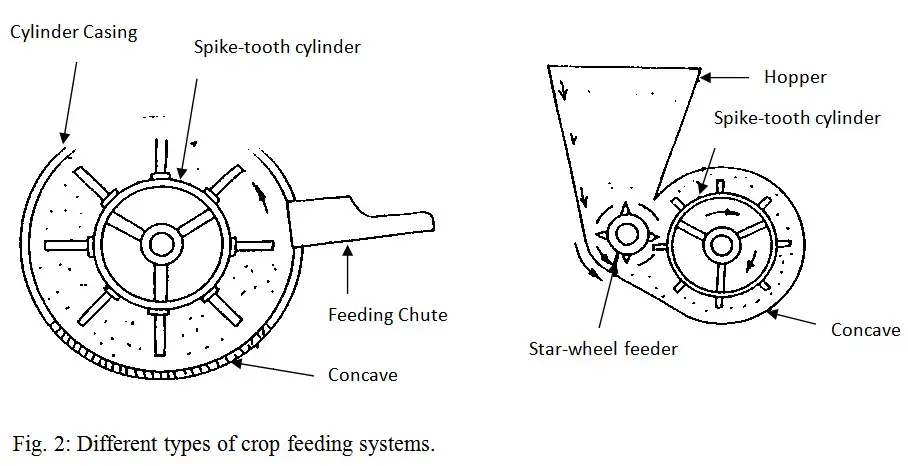
This image is property of ecoursesonline.iasri.res.in.
9. How Spike-Tooth-Cylinder Threshers Work
9.1 Combination of Spike-Tooth and Drum
Spike-tooth-cylinder threshers combine the principles of spike-tooth and drum threshers. These threshers have toothed cylinders with spikes and include a rotating drum, enhancing the threshing process.
9.2 Feeding and Threshing Stage
The grain stalks are fed into the thresher, where the toothed cylinders pull them between the spikes. Simultaneously, the rotating drum further aids in separating the grain from the straw, enhancing the efficiency of the threshing process.
9.3 Cleaning Stage
After the feeding and threshing stage, the separated grains and straw pass through a cleaning system. The cleaning system removes any remaining straw or debris, ensuring the collected grains are clean.
9.4 Power Transmission
Spike-tooth-cylinder threshers require an external power source, just like other types of threshers. The power is transmitted to the rotating toothed cylinders and the drum, enabling the threshing process.
10. How Centrifugal Threshers Work
10.1 Drum and Beater Design
Centrifugal threshers feature a drum and beater system, similar to rotary threshers. However, the design of the drum and beater system is optimized to create a centrifugal force during operation.
10.2 Threshing and Separation Stage
The grain stalks are fed into the thresher, where the rotating drum and beater system generate a centrifugal force. This force aids in the separation of the grain from the straw, as the grains are flung to the outer edge of the rotating drum.
10.3 Cleaning Stage
After the threshing and separation stage, the separated grains and straw pass through a cleaning system. The cleaning system removes any remaining debris or chaff, ensuring the collected grains are clean.
10.4 Power Transmission
Centrifugal threshers, like other types of threshers, require an external power source. The power source drives the rotation of the drum and the beater system, enabling the threshing process.
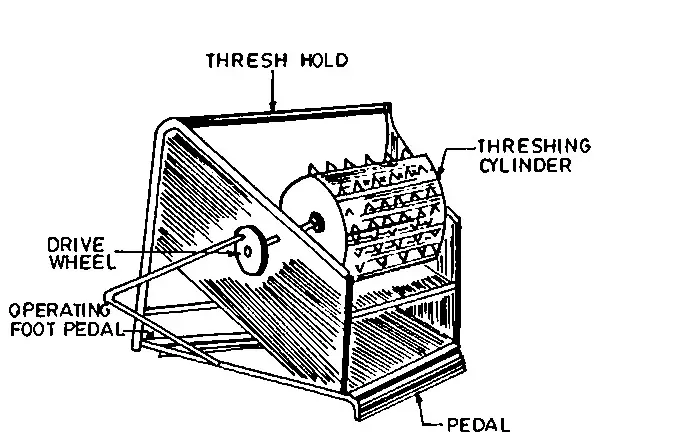
This image is property of ecoursesonline.iasri.res.in.
This post may contain affiliate links which means I may receive a commission for purchases made through links. Learn more on my Private Policy page.

